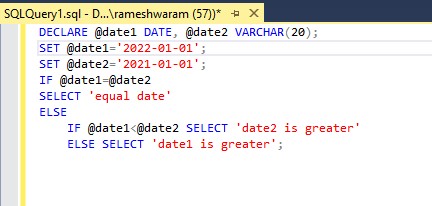Comparing dates in SQL is a fundamental skill for database management and analysis. This article provides a comprehensive guide on how to effectively compare dates using SQL queries, employing comparison operators and conditional statements for accurate results. Understanding date comparisons is crucial for tasks like filtering data, identifying trends, and scheduling events within a database.
Understanding SQL Date Datatype and Formats
SQL utilizes the DATE datatype to store dates in ‘yyyy-mm-dd’ format. This standardized format ensures consistency in date representation and facilitates accurate comparisons. While variations exist across different database systems (e.g., DATETIME, TIMESTAMP), understanding the core DATE type is essential.
Comparing Dates with Operators
SQL offers straightforward comparison operators for date comparisons:
- Equals to (=): Checks if two dates are identical.
- Less than (<): Checks if the first date is earlier than the second date.
- Greater than (>): Checks if the first date is later than the second date.
- Less than or equal to (<=): Checks if the first date is earlier than or equal to the second date.
- Greater than or equal to (>=): Checks if the first date is later than or equal to the second date.
- Not equal to (!= or <>): Checks if two dates are different.
These operators enable direct comparisons within WHERE clauses to filter records based on date criteria. For instance, to retrieve all orders placed before a specific date:
SELECT order_id, order_date
FROM orders
WHERE order_date < '2023-10-27';Utilizing Conditional Statements for Date Comparisons
Conditional statements, such as IF-ELSE, enhance date comparison logic by allowing different actions based on the comparison outcome.
Syntax:
IF Boolean_expression
BEGIN
-- SQL statement(s) if the condition is true
END
ELSE
BEGIN
-- SQL statement(s) if the condition is false
END;Combining comparison operators with IF-ELSE allows for complex logic, like categorizing records based on date ranges.
Declaring and Setting Variables for Date Comparison
For more dynamic comparisons, declare variables using DECLARE and assign values using SET.
DECLARE @date1 DATE, @date2 DATE;
SET @date1 = '2024-01-15';
SET @date2 = '2024-02-20';
IF @date1 < @date2
SELECT 'Date1 is earlier than Date2';
ELSE
SELECT 'Date1 is not earlier than Date2';This approach facilitates reusable code and simplifies complex queries. Note that variable names in SQL Server typically start with @.
Comparing Dates with Different Datatypes
SQL can often implicitly convert datatypes for comparison. For instance, comparing a DATE variable with a VARCHAR string containing a valid date format usually works seamlessly. However, explicit conversion using functions like CAST or CONVERT is recommended for clarity and to avoid potential errors.
DECLARE @date1 DATE, @date2 VARCHAR(20);
SET @date1 = '2024-03-10';
SET @date2 = '2024-03-15';
IF @date1 = CAST(@date2 AS DATE)
SELECT 'Dates are equal';
ELSE
SELECT 'Dates are not equal';Conclusion
Mastering date comparisons in SQL is essential for effective data management. Utilizing comparison operators, conditional statements, and variables provides a robust toolkit for filtering, analyzing, and manipulating date-related data. Remember to consider datatype consistency and leverage explicit conversion functions when necessary for accurate and reliable results.

